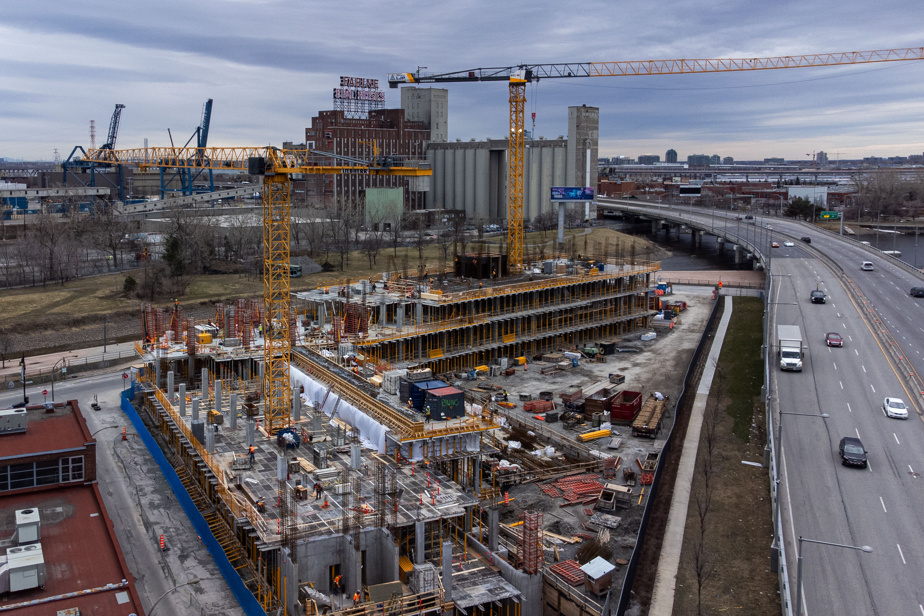As part of an ambitious international competition encouraging cities to reinvent themselves, Montreal has entrusted an inhospitable piece of land bordered by the Bonaventure Expressway and the Lachine Canal to an experienced team that has distinguished itself by its desire to establish a new way of living. The challenge ahead is immense, senior officials at Pomerleau and Cogir Immobilier revealed during virtual interviews. Report.
A mini-district with immense environmental and community goals is under construction at the junction of the Old Port and Griffintown. The Haleco project was set in motion a year ago, with the firm intention of taking up the 10 climate challenges launched by the global network of major cities C40, organizer of the international competition Reinventing Cities, and which aims to encourage low-carbon urban regeneration.
Three partners with complementary fields of expertise have led the project since it won the Réinventer Montréal competition in 2019: Pomerleau, Cogir Real Estate and Ivanhoé Cambridge, real estate branch of the Caisse de dépôt et placement du Québec. The agencies ACDF Architecture and the ŒUF (Office of Urban and Functional Eclecticism) complete the team.
“The competition was built around 10 categories of performance indicators, such as green buildings and energy efficiency, low-carbon mobility, inclusive actions and social benefits,” explains Andréa Vickers, sustainable development advisor at Pomerleau. In seeking LEED Platinum certification for the building, which is the highest level to be achieved, we looked in great detail at the materials we use. »
“Our professionals aren’t used to doing that,” she says. We will also do a follow-up after construction. We have simulations upstream regarding energy consumption and water consumption, but to see if it works according to our assumptions is really interesting for a building like this. »
The 21-story complex will feature 327 rental units, including 77 affordable units, offices, circular economy-focused retail on the ground floor, and an associated 40-unit housing co-op.
“In a land that was a former asphalt road yard, we reduced the space occupied by the building as much as possible, so that green spaces cover more than 50% of the land, underlines Gaëlle Hazzan, project director, real estate development, at Cogir Immobilier. These green spaces, as well as the large commercial hall, will be open to the public, to establish a dynamic of being together and a feeling of community. »
The search for carbon neutrality translates into a thousand and one ways. Walking and cycling, for example, will be strongly encouraged. Pride of place will also be given to urban agriculture, part of which will take place indoors, in a section of the underground parking lot, with a view to supplying restaurant areas and a grocery store on the site, as well as the tenants in the tower.
“Urban agriculture is still very theoretical,” notes Étienne Gravel, director, sustainable construction, at Pomerleau.
“Different tests are being done. We will be good for hydroponics and growing mushrooms, which do not require natural light. It is good to add this objective in the context of the project, because a private developer would have long ago decided not to do so,” he adds.
The study of materials has been pushed very far in order to innovate. To reduce the environmental impact of the concrete used, the team uses a type of concrete that incorporates a residue from industrial production. All windows will also have triple glazing. “It’s very rare,” says Nicolas Sharp, senior project manager at Pomerleau. This obviously helps with the energy efficiency of the building and to counter the noise pollution coming from the highway next door. »
Introducing new ways of doing things is far from easy, notes Stéphane Côté, president of the major projects division at Cogir Immobilier. “A lot of people will say we could have done this or that differently, but I’m telling you, it’s quite a headache,” he says. We are building the next rocket to go to Mars and there is a lot to learn. What makes me most proud is that we do it. Many of these projects are abandoned. Like all prototypes, the next one will be better and we will continue to improve. This is how you start a change. Otherwise, it remains theoretical. We ask ourselves 20,000 questions, we make decisions, and then we move on. »
The first tenants are expected to move in in the fall of 2024. Reservations will begin in late summer.
“Ha” for housing “le” for LEED Platinum certification “eco” for ecological challenges and circular economy “co” for community















